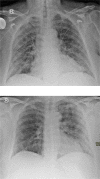Model-based Prediction of Critical Illness in Hospitalized Patients with COVID-19
- PMID: 32787701
- PMCID: PMC7427120
- DOI: 10.1148/radiol.2020202723
Model-based Prediction of Critical Illness in Hospitalized Patients with COVID-19
Abstract
Background The prognosis of hospitalized patients with severe coronavirus disease 2019 (COVID-19) is difficult to predict, and the capacity of intensive care units was a limiting factor during the peak of the pandemic and is generally dependent on a country's clinical resources. Purpose To determine the value of chest radiographic findings together with patient history and laboratory markers at admission to predict critical illness in hospitalized patients with COVID-19. Materials and Methods In this retrospective study, which included patients from March 7, 2020, to April 24, 2020, a consecutive cohort of hospitalized patients with real-time reverse transcription polymerase chain reaction-confirmed COVID-19 from two large Dutch community hospitals was identified. After univariable analysis, a risk model to predict critical illness (ie, death and/or intensive care unit admission with invasive ventilation) was developed, using multivariable logistic regression including clinical, chest radiographic, and laboratory findings. Distribution and severity of lung involvement were visually assessed by using an eight-point scale (chest radiography score). Internal validation was performed by using bootstrapping. Performance is presented as an area under the receiver operating characteristic curve. Decision curve analysis was performed, and a risk calculator was derived. Results The cohort included 356 hospitalized patients (mean age, 69 years ± 12 [standard deviation]; 237 men) of whom 168 (47%) developed critical illness. The final risk model's variables included sex, chronic obstructive lung disease, symptom duration, neutrophil count, C-reactive protein level, lactate dehydrogenase level, distribution of lung disease, and chest radiography score at hospital presentation. The area under the receiver operating characteristic curve of the model was 0.77 (95% CI: 0.72, 0.81; P < .001). A risk calculator was derived for individual risk assessment: Dutch COVID-19 risk model. At an example threshold of 0.70, 71 of 356 patients would be predicted to develop critical illness, of which 59 (83%) would be true-positive results. Conclusion A risk model based on chest radiographic and laboratory findings obtained at admission was predictive of critical illness in hospitalized patients with coronavirus disease 2019. This risk calculator might be useful for triage of patients to the limited number of intensive care unit beds or facilities. © RSNA, 2020 Online supplemental material is available for this article.
Figures





References
-
- Huang C, Wang Y, Li X, Ren L, Zhao J, Hu Y, Zhang L, Fan G, Xu J, Gu X, Cheng Z, Yu T, Xia J, Wei Y, Wu W, Xie X, Yin W, Li H, Liu M, Xiao Y, Gao H, Guo L, Xie J, Wang G, Jiang R, Gao Z, Jin Q, Wang J, Cao B. Clinical features of patients infected with 2019 novel coronavirus in Wuhan, china. Lancet [Internet]. 2020 Feb 15;395(10223):497-506. - PMC - PubMed
-
- Chen N, Zhou M, Dong X, Qu J, Gong F, Han Y, Qiu Y, Wang J, Liu Y, Wei Y, Xia J, Yu T, Zhang X, Zhang L. Epidemiological and clinical characteristics of 99 cases of 2019 novel coronavirus pneumonia in Wuhan, china: A descriptive study. Lancet [Internet]. 2020 Feb 15;395(10223):507-13. - PMC - PubMed
-
- Guan WJ, Ni ZY, Hu Y, Liang WH, Ou CQ, He JX, Liu L, Shan H, Lei CL, Hui DSC, Du B, Li LJ, Zeng G, Yuen KY, Chen RC, Tang CL, Wang T, Chen PY, Xiang J, Li SY, Wang JL, Liang ZJ, Peng YX, Wei L, Liu Y, Hu YH, Peng P, Wang JM, Liu JY, Chen Z, Li G, Zheng ZJ, Qiu SQ, Luo J, Ye CJ, Zhu SY, Zhong NS, China Medical Treatment Expert Group for Covid-19. Clinical characteristics of coronavirus disease 2019 in china. N Engl J Med [Internet]. 2020 Apr 30;382(18):1708-20. - PMC - PubMed
MeSH terms
LinkOut - more resources
Full Text Sources
Other Literature Sources
Medical
Research Materials
Miscellaneous

